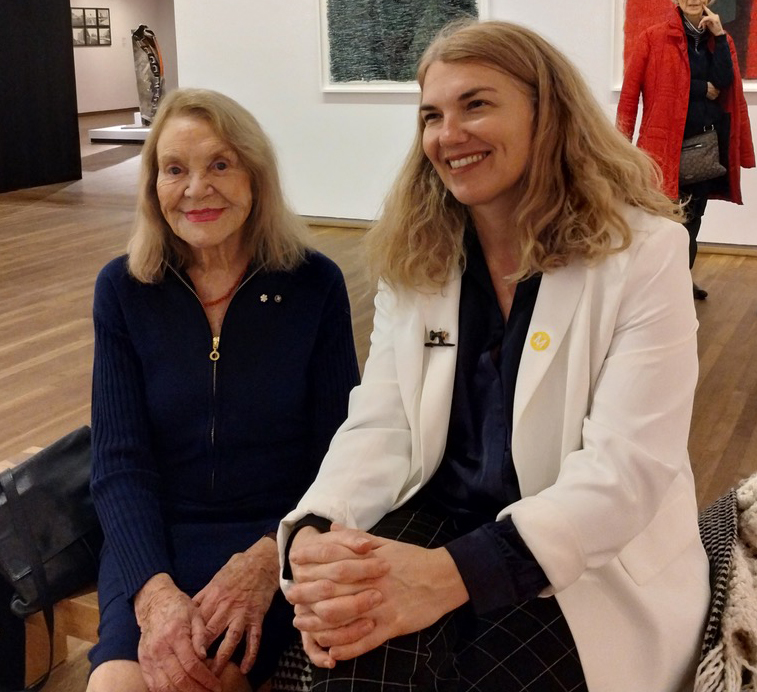Montréal, le 16 septembre 2022 — Nous avons le regret d’annoncer le décès de notre amie Jeanne Renaud, grande artiste, chorégraphe, danseuse, pédagogue et directrice artistique, qui s’est éteinte le 15 septembre à l’âge de 94 ans.
Née à Montréal le 27 août 1928, Jeanne Renaud a formé avec ses deux sœurs, feu la poétesse Thérèse Renaud et feu la peintre Louise Renaud, une fratrie de trois femmes artistes qui ont profondément marqué le milieu de l’art au Québec. Elle était aussi la sœur de feu Louis Renaud, photographe décédé dans un accident d’avion. Elle a été la conjointe de feu le docteur Jean-Pierre Labrecque et de feu le photographe Ed Kostiner. Elle laisse dans le deuil son fils Sylvain Labrecque (Sophie Lebeau) — sa fille Michelle Labrecque l’a précédée dans la mort —, sa filleule Isabelle Leduc, fille de Thérèse Renaud et Fernand Leduc, sa nièce Barbara Kloeppel, fille de Louise Renaud et de Francis Kloeppel, Lolly Renaud, fille de Louis Renaud, ses petits-enfants Renaud et Vincent Bégin, son arrière-petit-fils Guillaume ainsi que de nombreux amis.
Aux côtés de Françoise Sullivan et de Françoise Riopelle, Jeanne Renaud aura été une des pionnières de la danse moderne au Québec. Elle commence sa formation de danseuse avec Elizabeth Leese et Gérald Crevier à Montréal, puis avec Merce Cunningham, Hanya Holm et Mary Anthony à New York en 1946. Avec Françoise Sullivan, elle présente ses premières chorégraphies à Montréal en 1948. Artiste intimement liée aux Automatistes, mais mineure en 1948, elle n’est pas invitée à signer le manifeste Refus global comme l’ont fait ses sœurs Louise et Thérèse.
Jeanne Renaud séjourne à Paris de 1949 à 1952, où elle rejoint Fernand Leduc et ses sœurs Thérèse et Louise, Jean Paul Riopelle et Françoise Lespérance-Riopelle. Elle enseigne la danse et présente un spectacle le 3 mars 1950 à l’American Student’s and Artists’ Center de Paris, en collaboration avec le peintre Jean Paul Riopelle et les compositeurs Pierre Mercure et Gabriel Charpentier. À Montréal, en 1965, elle présente le spectacle Expression 65 dont le grand succès l’encourage à fonder, en 1966, le Groupe de la place Royale, assisté de Peter Boneham. Elle s’y illustre comme chorégraphe, danseuse et directrice artistique jusqu’en 1972. Au cours des années 1970 et 1980, Jeanne occupe plusieurs postes administratifs et artistiques : en 1970-1971, elle est professeure à l’École nationale de théâtre et au cégep Lionel-Groulx. De 1972 à 1975, elle fonde et dirige avec Ed Kostiner la Galerie III, dédiée à l’art contemporain; puis elle est agente des arts au Conseil des arts du Canada de 1975 à 1979 et au ministère des Affaires culturelles du Québec de 1979 à 1985, où elle est directrice du Service de la danse et attachée à la direction générale des conservatoires d’art dramatique du Québec. De 1985 à 1987, elle est la codirectrice artistique des Grands Ballets Canadiens aux côtés de Linda Stearns. Elle termine sa carrière en tant que professeure à la faculté des arts à l’Université du Québec à Montréal, de 1987 à 1989.
Encore récemment, Jeanne Renaud créait une chorégraphie pour le film Brèves histoires de pierres muettes (2018) du réalisateur Mario Côté et le Projet Feldman/Renaud à la Salle Bourgie en 2021, avec les danseurs Louise Bédard et Marc Boivin.
Tout au long de son parcours exceptionnel, Jeanne a fait des rencontres stimulantes avec les artistes québécois les plus marquants de leur époque. Sa feuille de route comprend plus de 40 chorégraphies dans lesquelles elle contribua à transformer la danse en discipline artistique contemporaine. Ses grandes réalisations lui valent l’obtention de prestigieux prix, parmi lesquels le prix Denise-Pelletier (1989) et le Prix du Gouverneur général du Canada pour les arts de la scène (1995), en plus d’être nommée membre de l’Ordre du Canada (1998) et compagne de l’Ordre des arts et des lettres du Québec (2018).
Le Québec se souviendra de Jeanne Renaud comme une grande pionnière des arts et une grande stimulatrice et mentore pour plusieurs créateurs et créatrices — feu Jean-Pierre Perreault, Sylvain Émard, Louise Bédard, Marc Boivin, et combien d’autres. Comme chorégraphe, Jeanne Renaud a toujours encouragé un dialogue fructueux avec les artistes visuels en intégrant à ses spectacles des créations de Françoise Sullivan, Fernand Leduc, Jean Paul Riopelle, Bruce Parsons, John Heward, entre autres, de même qu’avec les compositeurs contemporains, notamment Serge Garant, Gilles Tremblay et Walter Boudreau.
Nous nous souviendrons longtemps de l’influence qu’aura eue Jeanne Renaud sur nos vies personnelles et professionnelles. Nous lui en sommes très reconnaissants.
Ont signé : Son fils Sylvain Labrecque. Sa nièce Isabelle Leduc. Ses amies et amis, Rose-Marie Arbour, Michel Batlle, Marc Boivin, Louise Bédard, Mario Côté, Sylvain Émard, Cyrille Girard, Claude Gosselin, Laurier Lacroix, Jean Logan, Pierre Pilotte, Yseult Riopelle, Sylvia Safdie, Danielle Sauvage, Suzanne Sauvage, Richard Simas, Françoise Sullivan, Anne Viau, René Viau.
Plusieurs autres personnes auraient pu se joindre à nous si nous avions eu le temps de les contacter. Nous nous en excusons auprès d’elles.
Un hommage sera rendu à Jeanne Renaud dans quelques semaines. Parents et amis seront avisés. Contact : Claude.gosselin@ciac.ca














